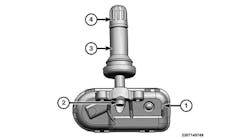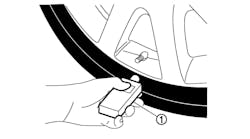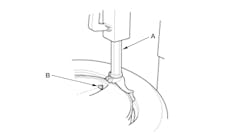As the season of summer heat draws near, it’s a good time to remember that vehicle batteries are taxed in any extreme environment and that makes it more likely vehicles will need battery service from your tire dealership in the coming months.
We asked the battery service experts for tips to help tire dealers and their technicians gear up for the summer season.
Jim O’Hara, executive vice president of merchandising, Clore Automotive Inc.: Batteries accept charge and provide discharge current differently based on temperature. That’s why it can be difficult to start a car in very low temperatures, as the cold suppresses the total power capacity of a given lead acid battery. This is why all lead acid batteries have a lower cold cranking amps (CCA) rating — zero degrees — than cranking amps (CA) rating — 32 degrees. As a result, it is important to use charging equipment that incorporates temperature compensation in the charge routine. This is also true for battery testing equipment, where battery temperature can impact the way that a digital tester would diagnose a battery.
While it makes sense that battery chemistry is sensitive to temperature, one wouldn’t normally think the same was true for vehicle control modules, but it is. Most OEMs now have a recommendation that the vehicle module temperature must be no higher than 68 degrees. As such, it is often necessary to cool the vehicle down prior to programming, which can pose challenges for service operations during periods of extreme summer heat.
Periods of extreme heat or extreme cold can be difficult for any battery-containing product, including jump starters. This is true whether the jump starter is of the lead acid or lithium variety. We recommend increasing your charge frequency during periods of extreme temperature, though it may be necessary to allow the jump starter’s temperature to normalize a bit prior to commencing a charge sequence. If the jump starter is above 100 degrees, less than zero degrees for lead acid (or less than 32 degrees for lithium), allowing it to (normalize) to room temperature is a best practice.
Ross Lopez, sales manager of new business development who specializes in batteries for GMB North America Inc.: Every year it is a good idea to check a vehicle’s battery at least twice - during the extreme weather seasons (of) winter and summer.
Summer temperatures increase the temperature inside the engine bay and accelerate the onset of battery failure. Higher temperatures have a greater impact on the power-generating chemicals inside. Excessive heat causes the battery's electrolyte fluid to evaporate, weakening the state of charge. This eventually leads to sulfation (crystals forming on the battery's plates), which prevents the battery's ability to recharge to full.
Car batteries typically last three to five years, with southern regions seeing the shortest lifespan. Check the battery's age. This can be done by locating the date code on the side of the battery. There will be a sticker with a month and year indicating when the battery was manufactured. The rule of thumb (for replacement) is if the battery is over three years old and there’s been an issue starting the vehicle.
Inspect the battery. Since the electrolyte inside of the battery contains sulfuric acid, be sure to wear your personal protective equipment. Vibration is one of the biggest factors when it comes to decreasing a battery’s life.
Make sure the battery is securely mounted into the compartment or tray. The less it shifts around, the better. Check that the terminals are tight enough not to twist around, and (that they are) free from cracks. Check the battery case for damage and wear.
Lastly, check for excessive corrosion, which will prevent the battery from receiving sufficient charge from the alternator. Clean the corrosion with a wire brush and add an anti-corrosive spray to slow its return.
Perform a load test. This is the best way to determine if a battery is about to fail. The test assesses its ability to hold voltage while in use. It simulates the load the engine uses to start the vehicle. A weaker result indicates the battery is likely to fail sooner than later, allowing you to replace it before it fails.
A digital load tester can provide data that will indicate its overall health. If the data says the battery is at 50% state of health, the unit should be replaced as soon as possible.
Nathan Gustafson, sales engineer at Midtronics Inc.: Summer heat causes more failures than winter. High temperatures adversely affect the electrolyte more than cold temperatures. So, testing in the summer is just as important — if not more — than wintertime.
Ensure connections are clean of corrosion, properly tightened and show no signs of wear (frayed wires, etc.) High resistance in connections can affect both starting and charging circuits.
Pay attention to battery conditions for overheating and out-gassing vapors from the electrolyte. Hot underhood temps and deteriorated batteries from heat can lead to higher potential for batteries out gassing. Charge in a well-ventilated area.
Haakan Light, training and development manager, Topdon USA: A pre-scan of the full vehicle upon initial arrival should be performed prior to any services on the 12-volt battery system.
Pay attention to repeat occurrences of "U codes" for communication stored in multiple modules and "battery voltage" related codes stored in multiple modules. This may indicate a problem with the 12-volt vehicle electrical system.
Every battery should be tested twice on a service visit: Once on initial arrival. The battery should be recharged, then tested a second time.
All batteries should be tested with a carbon pile load tester in addition to a standard digital battery tester, like the Topdon BT600.
Temperature extremes have a major impact on a vehicle battery's health. Sustained high and low temperatures can accelerate battery failures.
Many modern vehicles require a new battery to be coded or “learned” after replacement. For this operation, a scan tool is required.





